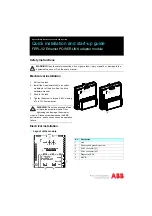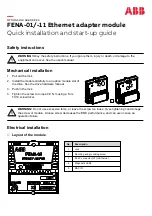
3
Warner Electric • 800-825-9050
P-1337-1 • 819-0317
Step 3: Burnishing and Maintenance
A. No burnishing required, units are
pre-burnished at factory.
B. Improper voltage setting can reduce the
braking life.
C. Wear grooves appear on the friction surfaces.
This is a normal wear condition, and does not
impair functioning of the unit. Never machine
the friction surfaces to remove grooves or
score marks resulting from normal wear.
D. Excessive heat and high operating
temperatures are causes of rapid wear.
Units should be ventilated as efficiently
as possible.
E. If brakes are used on machinery where fine,
abrasive dust, chips or grit are dispelled,
brake should be shielded.
F. Where brakes are used near a possible oil
contamination source, brake should be
shielded.
G. Oil and grease accidentally reaching the
friction surfaces may be removed by wiping
with a rag dampened with a suitable cleaner,
which leaves no residue. In performing this
operation, do not drench the friction material.
If the friction materials have been saturated
with oil or grease, no amount of cleaning will
be effective. Replace brake.
Brake Release Adjustment
The following procedure will
result in the brake releasing and allowing the
load to be free to move. Be sure the load is in
a safe condition before proceeding with this
process.
The following procedure describes how to set
the adjustable power supply to the optimum
release point of the brake. A volt-meter is
required to perform the procedure.
No power is applied to motor
during this procedure. Power normally
supplied by motor to brake control should
be supplied by alternate method.
1. With power off, connect the positive lead of
the power supply to the positive (red) lead of
the brake and the negative lead of the power
supply to the negative (black) lead of the
brake.
2. Connect a volt-meter to measure the voltage
applied across the brake.
3. Adjust the power supply to its lowest
possible output, then energize the power
supply only, to apply power to the brake.
4. Starting from the low point, slowly increase
the applied voltage until the brake armature
disengages from the magnet. Note and
record the applied voltage at this point.
5. Continue to slowly increase the applied
voltage until the armature re-engages the
magnet. If the maximum voltage available
from the supply does not cause the armature
to re-engage, the armature should be
manually assisted into engagement.
NOTE: If armature needs to be manually
assisted, armature should be pressed on
back side to make contact with friction
face of magnet.
6. With the armature re-engaged, slowly reduce
the applied voltage until the armature
disengages from the magnet. Note and
record the applied voltage at this point.
7. The optimum release point for the brake is
half-way between the two recorded voltage
readings. Adjust the supply to this optimum
release voltage.
NOTE: The above procedure should be
done by visually watching the armature
move and may be repeated if necessary
from Step 1 through Step 7.
®
DIST. AUTORIZADO
MEX (55) 53 63 23 31
QRO (442) 1 95 72 60
MTY (81) 83 54 10 18
[email protected]






















